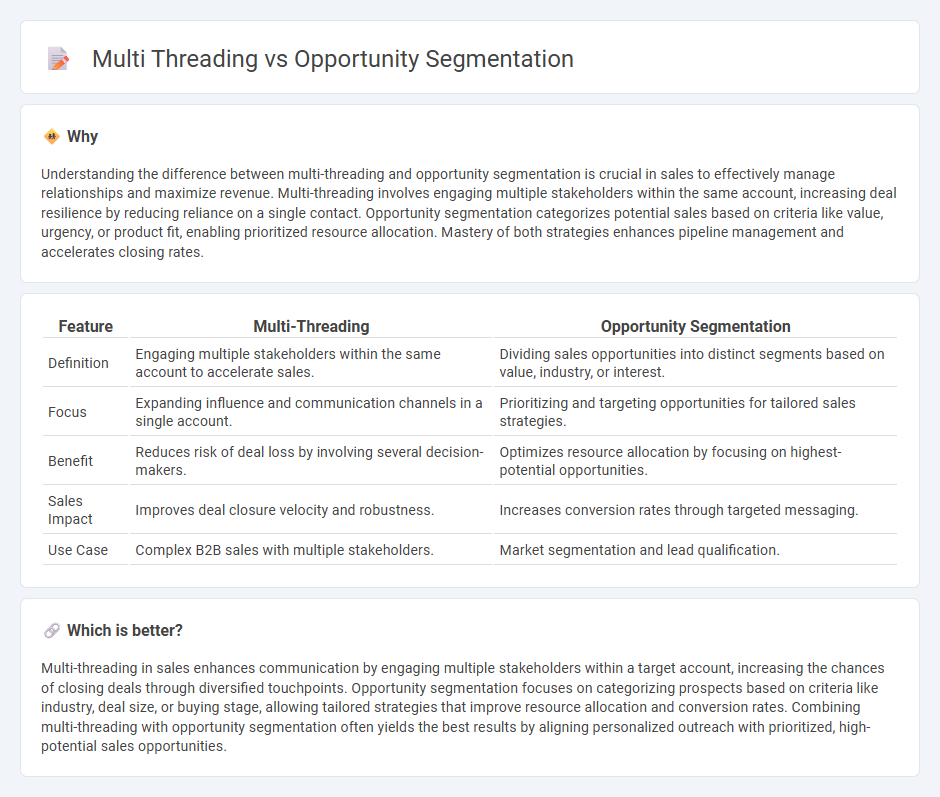
Multi-threading in sales involves engaging multiple stakeholders within a target account to increase deal success and reduce dependency on a single contact. Opportunity segmentation categorizes prospects based on criteria such as industry, company size, and buying behavior to tailor sales strategies effectively. Explore these techniques to enhance your sales performance and optimize your pipeline management.
Why it is important
Understanding the difference between multi-threading and opportunity segmentation is crucial in sales to effectively manage relationships and maximize revenue. Multi-threading involves engaging multiple stakeholders within the same account, increasing deal resilience by reducing reliance on a single contact. Opportunity segmentation categorizes potential sales based on criteria like value, urgency, or product fit, enabling prioritized resource allocation. Mastery of both strategies enhances pipeline management and accelerates closing rates.
Comparison Table
| Feature | Multi-Threading | Opportunity Segmentation |
|---|---|---|
| Definition | Engaging multiple stakeholders within the same account to accelerate sales. | Dividing sales opportunities into distinct segments based on value, industry, or interest. |
| Focus | Expanding influence and communication channels in a single account. | Prioritizing and targeting opportunities for tailored sales strategies. |
| Benefit | Reduces risk of deal loss by involving several decision-makers. | Optimizes resource allocation by focusing on highest-potential opportunities. |
| Sales Impact | Improves deal closure velocity and robustness. | Increases conversion rates through targeted messaging. |
| Use Case | Complex B2B sales with multiple stakeholders. | Market segmentation and lead qualification. |
Which is better?
Multi-threading in sales enhances communication by engaging multiple stakeholders within a target account, increasing the chances of closing deals through diversified touchpoints. Opportunity segmentation focuses on categorizing prospects based on criteria like industry, deal size, or buying stage, allowing tailored strategies that improve resource allocation and conversion rates. Combining multi-threading with opportunity segmentation often yields the best results by aligning personalized outreach with prioritized, high-potential sales opportunities.
Connection
Multi-threading in sales involves engaging multiple stakeholders across an organization to secure deals, enhancing communication and reducing single points of failure. Opportunity segmentation classifies potential sales based on criteria like industry, company size, or buying stage, allowing tailored multi-threading approaches for each segment. Together, these strategies optimize resource allocation and increase close rates by aligning sales efforts with segmented opportunities' unique decision-making dynamics.
Key Terms
Qualification Criteria
Opportunity segmentation involves categorizing prospects based on specific Qualification Criteria such as budget, authority, need, and timeline to prioritize sales efforts effectively. Multi-threading in sales refers to engaging multiple stakeholders within the same organization to improve deal qualification and increase closure rates by ensuring all decision-makers are involved. Explore how aligning Qualification Criteria with multi-threaded approaches enhances sales strategy and accelerates revenue growth.
Stakeholder Mapping
Opportunity segmentation enhances stakeholder mapping by categorizing individuals based on specific interests and influence, enabling targeted communication strategies. Multi-threading supports simultaneous engagement with diverse stakeholder groups, increasing efficiency in managing complex project interactions. Explore detailed methods to optimize stakeholder mapping through these approaches.
Buying Centers
Opportunity segmentation targets specific buying centers by categorizing prospects based on shared characteristics, decision-making roles, and purchasing behaviors. Multi-threading involves engaging multiple stakeholders within the same buying center to increase deal velocity and reduce reliance on a single point of contact. Explore how leveraging both strategies can optimize sales effectiveness and enhance account penetration.
Source and External Links
Opportunity Segmentation & Sales Comp for Tech Company - Opportunity segmentation involves creating a multi-variate model using factors like company sales, employee count, industry, and IT spend to identify and prioritize market segments, helping align sales roles, quotas, and compensation to growth goals effectively.
3 Reasons Why Segmentation Is the Foundation for New Opportunities - Segmentation clarifies the market landscape by grouping customers based on behaviors and needs, enabling businesses to identify underserved areas and customer pain points to find new growth opportunities.
Mastering Segmentation Strategy: A Comprehensive Guide - Opportunity segmentation is part of a broader strategy that involves dividing a market into distinct groups by demographics, behavior, or needs and then targeting the most attractive segments with tailored positioning and marketing efforts.
 dowidth.com
dowidth.com